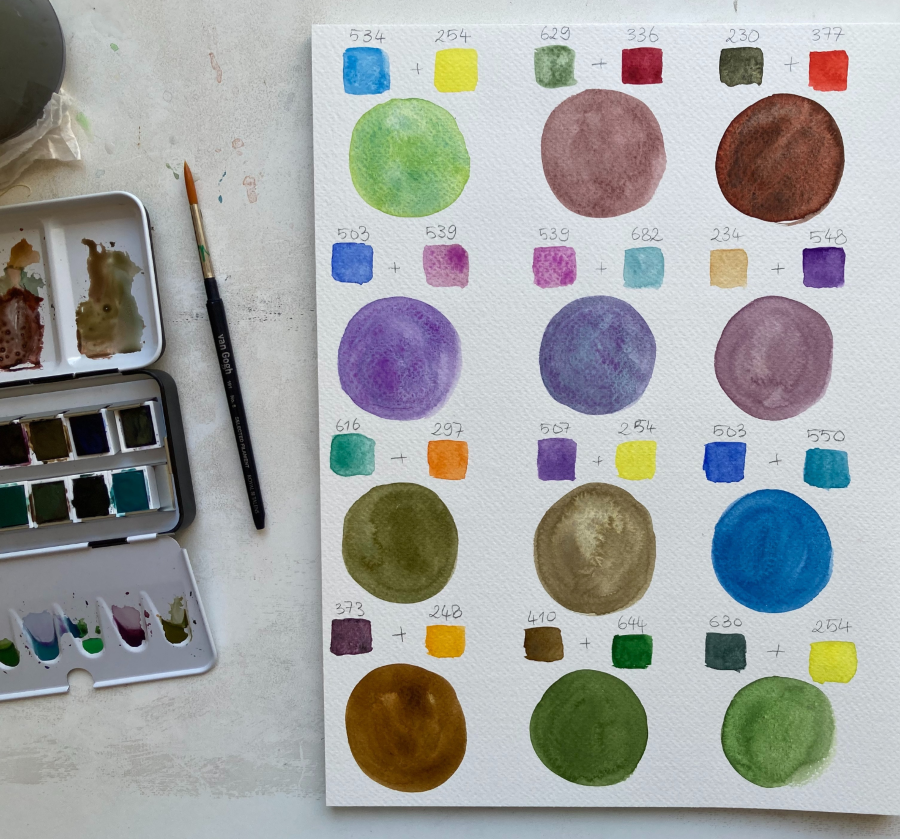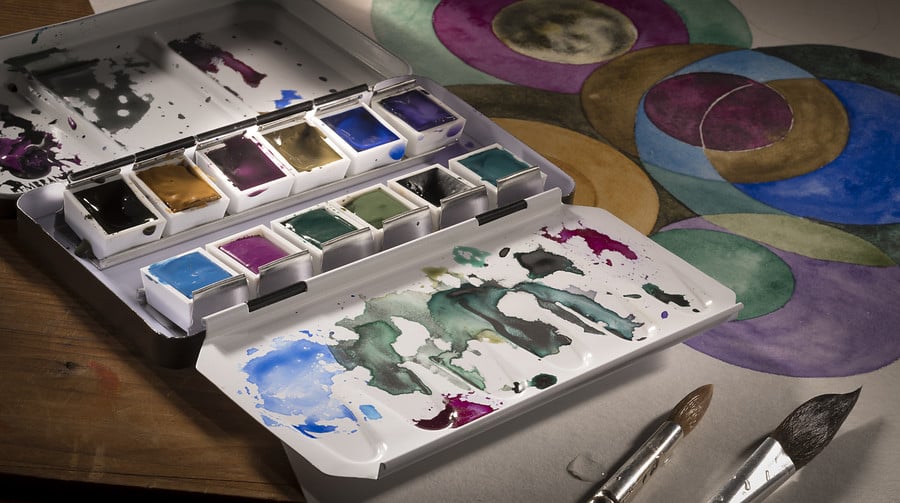
Granulating colours
If you're interested in water colours, you may have noticed the letter G next to some colour numbers in the colour charts or on the packaging of Van Gogh and Rembrandt water colours. This G stands for granulation. But what does granulation mean and how do you use these special colours? What happens when you mix them with regular water colours? Find out everything you need to know about granulating colours below!
What is a granulating colour?
Granulation is a property some paints have in which pigments pool together in small groups once applied. This produces a so-called flocculated or curdled effect. The granulated pigments will show up as small, unevenly dispersed dots and/or spots in the paint layer.
When you first apply the paint, it seems like a regular water colour, but you’ll quickly see the pigments bunch together while the paint dries. This effect offers some interesting spots and texture to an otherwise even coat of paint.
What can you use granulating colours for?
Granulating colours are a great and easy way to add natural textures to your water colour painting. Green granulating colours are often used to add texture to bushes, trees and grass, for instance, while brown shades can be used to create realistic sandy roads or the bark of a tree.
Another great way to use granulating colours is in portraits. Since our skin is never completely even, the spots caused by the curdled pigments can help you achieve rosy cheeks, freckles, imperfections or simply mimic the texture of skin. In abstract paintings, you can use granulating colours to create more variety in your composition.
Granulation works the best when used in a wet-on-wet technique. The large amount of water allows the pigments to roam freely and granulate in different spots while the water evaporates. The granulating effect of the colours will show up on any type of water colour paper. Smooth paper allows the pigments to settle anywhere they want, while a rougher type causes them to pool into the structure of the paper. Both types are worth experimenting with!
Examples of granulating colours
Ultramarine pigments usually are slightly granulating (not always), but there is a certain type of Ultramarine pigment that possesses this property more strongly than others. This type is usually given the name "French Ultramarine" and is used when a strong granulation effect is required.
Other typical examples of granulating colours are Cobalt Blue & Cobalt Green, Cerulean Blue, Raw Sienna, Green Earth, Gold Ochre and Oxide Black. The "Dusk” colours of both brands of water colours also make use of this property. Below you will find the complete lists of granulating colours in the Rembrandt and Van Gogh water colour collections.
Rembrandt
- Manganese Violet 596
- Ultramarine Violet 507
- Cobalt Violet 539
- Ultramarine Deep 506
- French Ultramarine 503
- Cobalt Blue 511
- Cerulean Blue Greenish 598
- Cerulean Blue Deep 550
- Cobalt Turquoise Green 682
- Viridian 616
- Green Earth 629
- Gold Ochre 231
- Raw Sienna 234
- Greenish Umber 410
- Oxide Black 735
- Dusk Yellow 230
- Dusk Pink 373
- Dusk Green 630
Van Gogh
- Turquoise Green 661
- Burnt Umber 409
- Davy’s Grey 748
- Oxide Black 735
- Dusk Yellow 230
- Dusk Pink 373
- Dusk Violet 560
- Dusk Green 630
Mixing granulating colours
Did you know you can make regular water colours granulate as well? If you mix a granulating colour with a normal colour, the effect will stay visible. Using this trick, you can create your own custom granulating colours!
Merel, our technical advisor, mixed the colours of the Rembrandt Granulating Colours Selection and the Landscape Colour Selection to showcase the effect. Of course, you can make any combination you’d like, but these examples clearly show you the interesting colours and textures you can create when you combine regular colours with granulating colours.




Do you use granulating colours in your work? If you do, we would love to see it! Share your work online using #RoyalTalens to inspire us and others to experiment with these interesting colours!





